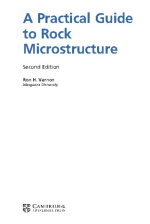A practical guide to rock microstructure / Практическое руководство по микроструктуре горных пород
Rocks in natural outcrops, in samples knocked off these outcrops and in drill cores, are beautiful and instructive. We can see different minerals, and identify many of them with the aid of a hand lens. We can also see some of the more obvious structures in the rocks. However, cutting a slice (section) through a rock with a diamond-impregnated circular saw and polishing the sawn surface shows us the various minerals alongside each other, rather than piled confusingly all around each other. This reveals the structure even more clearly, as can be seen in the polished facing slabs on many buildings and bench tops.
But we always want to see more. So, when D. Brewster, in 1817, and William Nicol, in about 1830, showed how to make a slice of crystalline material thin enough to transmit light (0.03 mm is the standard thickness) and stuck it to a glass microscope slide (Shand, 1950, p. 6; Loewinson-Lessing, 1954), it was not surprising that a curious person, such as Henry Sorby, should start looking at these thin sections of rocks (Sorby, 1851, 1853, 1856, 1858, 1870, 1877, 1879, 1908). Sorby learnt the technique of making thin sections from W. C. Williamson in 1848 (Judd, 1908; Folk, 1965) and made the first rock thin section in 1849 (Judd, 1908). Sorby was the first to look seriously at rock sections with the microscope, beginning with a study of chert, a siliceous sedimentary rock that was a very appropriate choice for microscopic investigation in view of its very fine grain size. He described and suggested a mechanical origin for slaty cleavage (Sorby, 1853, 1856); noticed many of the basic features of igneous and metamorphic rocks; made many important observations on sedimentary rocks, including carbonate rocks (Sorby, 1879); investigated pressure solution (using fossil crinoids); described meteorites; and published the first papers on the examination of polished sections of metals with the microscope (Sorby, 1864, 1887). Thus, Sorby is not only the founder of petrography (the description of rocks), but also the founder of metallography as well (Smith, 1960). In 1858 he investigated fluid inclusions in minerals, heating crystals to watch the gas bubbles disappear, in order to
get an estimate of the temperature of crystallization of the mineral (Folk, 1965). <...>




